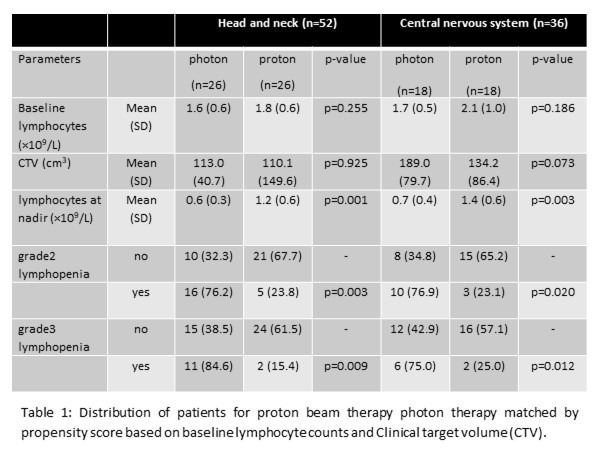Proton therapy reduces the incidence of severe lymphopenia compared with photon
PD-0164
Abstract
Proton therapy reduces the incidence of severe lymphopenia compared with photon
Authors: Azadeh Abravan1, Peter Sitch2, Marcel van Herk1, Simona Gaito2, Andrew McPartlin2, Srijith Sashidaran3, Ed Smith2, Gillian Whitfield1, Shermaine Pan2
1The University of Manchester, Division of cancer sciences, MANCHESTER, United Kingdom; 2The Christie NHS Foundation Trust, Proton beam therapy, MANCHESTER, United Kingdom; 3Velindre University NHS Trust, Clinical oncology, Cardiff, United Kingdom
Show Affiliations
Hide Affiliations
Purpose or Objective
Radiotherapy-induced lymphopenia may be
associated with adverse outcome and reduced survival in various cancer types.
Due to unique dosimetric characteristics, proton therapy can reduce the volumes
of healthy tissue irradiated, potentially sparing lymphocytes. We investigated
the incidence of severe lymphopenia in patients treated with either photons or
protons, whose radiation treatment site included head and neck (H&N) and
central nervous system (CNS).
Material and Methods
Data from 44 patients treated with
proton therapy and 44 with photon therapy at a single institute for H&N
(n=52) or CNS (n=36) were included. Base of skull treatment were included in
the H&N category. All patients had lymphocyte counts at baseline (< 90
days prior to radiotherapy) and during radiotherapy. Severe lymphopenia grade 3
or higher was based on lymphocytes at nadir during RT < 0.5x109/L
(CTCAE v5.0). If case of multiple clinical target volumes (CTVs), the largest
CTV was used in the analysis. Vx was calculated from RT images and is a volume
receiving x Gy or higher in the body normalized to body weight to account for
patients’ size. For patients without weight data, it is imputed using a 3rd
power fit of weight vs age from the available data. Multivariable logistic
analysis was conducted to investigate the association between the incidence of
severe lymphopenia and patients’ clinical, demographics, and dosimetric factors.
To avoid multi-collinearity, dosimetric parameters were included in the
multivariable regression one at a time together with other factors known to
affect lymphocytes.
Results
Four (9%) and 17 (39%) of the patients developed grade 3 lymphopenia in the proton and photon treatment arm, respectively. There was a good match of baseline lymphocytes and CTV between proton and photon arms for each disease site (Table 1). However, lymphocyte counts during radiotherapy and the incidence of grade 2 and grade 3 lymphopenia was significantly lower in the proton arm. As seen in Table 2, in the univariable model, proton therapy was associated with the reduced risk of lymphopenia, however, it became insignificant when including dosimetric parameters in the multivariable model. Multivariable logistic regression adjusted for age, gender, treatment arm, and disease site suggested that lower baseline lymphocytes and larger volumes receiving 2‒30 Gy (V2, V5, V10, V20, V30) are associated with higher risk of developing grade 3 or higher lymphopenia during radiotherapy.


Conclusion
Our study suggests that in H&N and
CNS treatment, protons reduce the risk of severe treatment-related lymphopenia.
Proton therapy reduces the volume receiving low to intermediate doses (V2
-V30) and subsequently reduces grade 3 or higher lymphopenia.